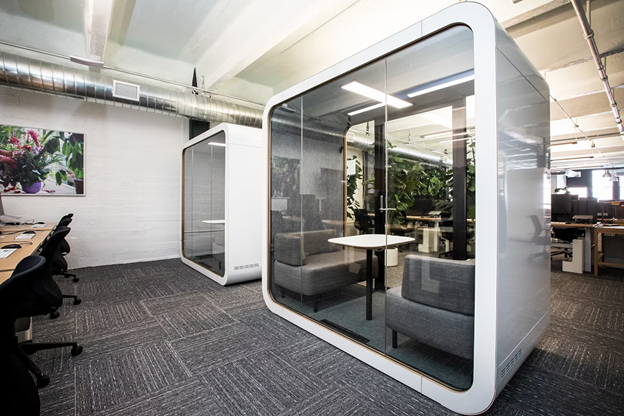From the way layouts enhance collaboration to the function of colors and furnishings, various aspects contribute to a stimulating work environment. This article explores how thoughtful design transforms office spaces into hubs of productivity.
Understanding the Impact of Office Layout
The arrangement of an office layout influences how employees communicate, collaborate, and engage in their tasks. Traditional layouts, often characterized by closed-off cubicles, can inadvertently promote isolation among employees. Research shows that such environments result in decreased interaction and, consequently, lower job satisfaction. Open floor plans, on the other hand, support collaboration. They promote candid communication and idea exchange by removing obstacles, which eventually raises production levels.
Each layout comes with its advantages and disadvantages, influencing engagement and focus. Informal break-out areas can provide a space for relaxation, sparking creativity and fresh ideas. Properly designed workspaces take strategy into account, balancing quiet zones for focused work with collaborative areas where teamwork thrives. Finding the right mixture enhances communication and ensures employees feel supported in their roles.
Color Psychology and Workplace Motivation
Color plays an integral role in office design, affecting mood and productivity. Research in color psychology indicates that specific colors elicit various emotional responses from people. Blue often conjures feelings of calmness and stability, while yellow is associated with enhanced creativity and energy. When it comes to using colors that boost office productivity, incorporating elements of these shades can have a visible impact on performance. Selecting the right color palette for an office can create environments that nurture productivity.
Use vibrant hues for creative spaces that stimulate the mind or muted tones for areas requiring concentration. The psychological associations of colors effectively guide how employees feel and perform throughout the day. Thus, integrating colors that resonate with workplace goals enhances motivation and job satisfaction.
The Role of Ergonomics in Office Design
Ergonomics should be a cornerstone of any office design strategy. A well-designed workspace accommodates the physical needs of employees, reducing strain and discomfort. Ergonomic desks and chairs decrease the risk of musculoskeletal injuries, promoting healthier working habits. Comfortable seating arrangements enhance focus and support longer periods of productivity. When employees feel physically supported, they are more likely to concentrate on their tasks and engage fully.
Incorporate adjustable desks that allow for both sitting and standing. This adaptability meets the needs of various employees, accommodating individual preferences and promoting different working styles. The right ergonomic solutions create an inclusive workspace, enabling everyone to perform at their best without the distraction of discomfort. A focus on ergonomic design directly links to improved motivation and productivity outcomes.
The Integration of Technology in Modern Offices
Technology has revolutionized how we view office spaces with innovations that facilitate collaboration and communication. Modern offices often include advanced tools such as smart boards, high-speed internet, and conference rooms equipped with interactive technology that enhances meetings and presentations. Integrating technology into office design allows for seamless communication, enabling teams to collaborate more efficiently, regardless of their physical location. Modern solutions such as APSO serviced offices come fully equipped with high-speed internet, meeting rooms, and advanced facilities that make collaboration effortless.
Equipping spaces with state-of-the-art technology maximizes productivity by minimizing disruption and workflow interruptions. Features like video conferencing allow for effective communication across distances, fostering an inclusive work environment. Implementing these technologies contributes to a more dynamic office atmosphere, allowing employees to engage in their work without unnecessary delays or complications.
The Influence of Nature on Productivity
Biophilic design focuses on connecting the natural world with the office environment. Numerous studies support the idea that incorporating elements of nature into the workspace significantly enhances employee well-being and performance levels. Natural light, plants, and outdoor views bring a fresh perspective to office life, making workspaces more inviting. Reports indicate that employees exposed to natural light experience reduced stress levels and improved concentration.
Integrating plants into office spaces beautifies the environment and improves air quality, which can positively influence mood and creativity. Organizations that prioritize biophilic design strategies report higher job satisfaction and lower employee turnover rates. Bringing elements of nature indoors cultivates an atmosphere that encourages productivity while promoting health and well-being.
Creating Collaborative Spaces
Dedicated collaborative spaces foster teamwork and innovation among employees. Establishing spaces that promote impromptu meetings can help organizations generate fresh concepts and projects. Comfortable seating, whiteboards for brainstorming sessions, and areas for casual meetings can create a sense of community. Studies indicate that collaboration leads to higher efficiency and can accelerate project outcomes. When employees feel comfortable discussing their ideas and solutions collectively, motivation naturally rises.
Collaborative spaces encourage a culture of teamwork, where individuals contribute freely and supportively. An environment that promotes social interaction nurtures creativity, ultimately benefiting the organization as a whole. Companies that invest in these dynamic spaces see substantial performance increases attributable to enhanced interpersonal connections.
Flexible Design and Its Benefits
Flexibility in office design is becoming a fundamental consideration for modern organizations. Employees appreciate the ability to customize their work environment according to their needs. Arrangements that allow for quick transformations from solitary work areas to collaborative zones enable employees to switch modes efficiently. Flexibility supports evolving work patterns and preferences, accommodating various teams and their unique requirements. Implementing movable furniture and adjustable workspaces contributes to a more versatile environment. Employees are more engaged when they can adapt their surroundings.
This adaptability makes it easier for businesses to respond to organizational growth or downsizing without major renovations. It promotes better space utilization and can reduce overhead costs in the long run. Flexible designs can improve health by encouraging movement throughout the day, which may reduce sedentary behavior. A dynamic environment signals innovation and openness, qualities that appeal to both employees and clients. As work culture continues to evolve, flexibility will remain a cornerstone of effective and inclusive office design.
This adaptability improves motivation and reduces feelings of restriction. Modern offices embracing this design philosophy help teams feel empowered to manage their environments, significantly impacting their productivity rates. With the right office design, organizations can build spaces that enhance performance and boost morale across their teams.






